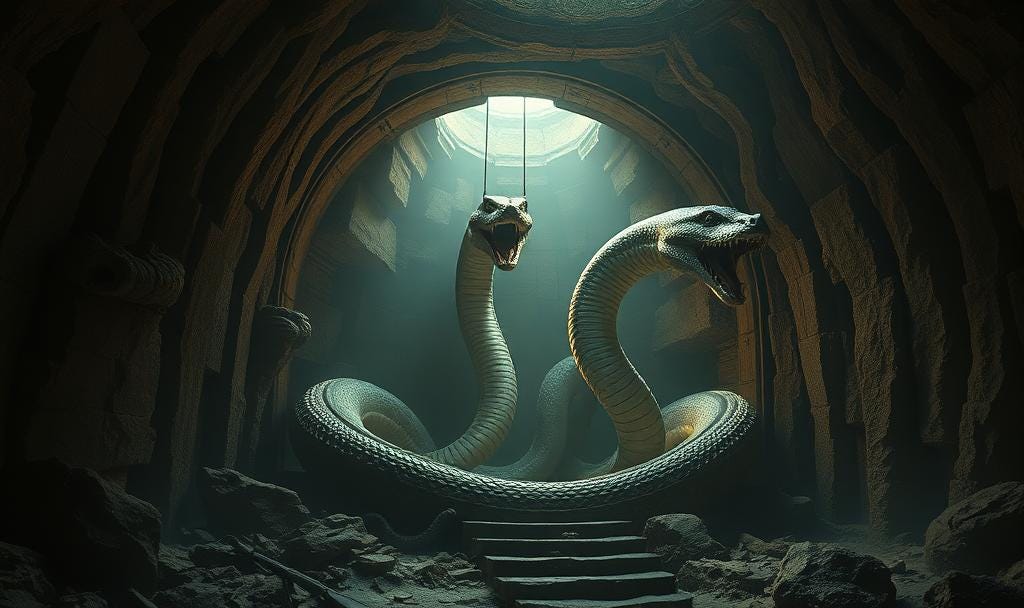Today I brought you a collection of Legends about the life of king Roderick, the last king of the Visigoths, but before I let you read the legends, I will explain to you who this man was. First, it’s important to understand that the Visigoths chose their king through election, not an election like today’s, but an election in which only the elite voted and only the elite could be elected. So, when the previous King, Witiza, died, it was the desire of some, including his widow, that one of his sons would be elected king, but that was not the case1. Roderick was elected instead, but he also the elite: he was a Dux (Count), and his grandfather, Chindaswinth, had also been king. He was never fully recognised as king in all Kingdom2, and eventually the Ummayad Caliphate conquered the Peninsula.
There are many legends about this king, probably for having been the last, but also because he his a fascinating man, at least for me. The three prophecies I brought you are about Roderick, but also about the fall of the Visigoths, since both these themes are intertwined.
The Prophecy
In a pit, a mile from Toledo, there was a ruined tower turned against east, and at its entrance it was written in Greek: “The King who opens this pit, and who discovers the wonders herein contained, will find both good and evil”. Inside the pit strange and horrendous sounds could be heard, and these sounds scarred the kings who came before Roderick, and because of it they would always out one more lock and would never enter the pit; but Roderick was so desirous to find a treasures, that he entered with many lamps.
He walked inside the pit until he entered a block where he found a Giant figure of metal who would beat with an Apple made of metal on the floor, making a sound that would eco for all the pit until its entrance. When the king entered, the metal statue stopped beating the floor and with the left hand pointed to the wall where it was written: “Misfortuned king by your evil you entered here”, and with its right hand it pointed to a wall where it was written: “By a strange nation you will be dethroned, and your people severelly punished”. On the back of the statue it was written: “ I invoked the arabs”, and in the chest: “I do my calling”. On the same block there was a mouth where the pit continued, but the King was feeling so despondent that he died not want to proceed, so the statue changed its costumary movement. To silence the pit, the king ordered the pit to be filled with first, but the Next night sounds of Battle could be heard, and the tower built over the rocks that were Over the pit, fell.
Source: BRITO, Friar Bernardo, Monarchia Lusytana, Livro VII, Segunda Parte, CAP. 1, pág. 373
Roderick and Count Julian
When king Roderick rose to power he desired to gain the favour of Count Julian and so he agreed to marry his daughter, Florinda. But, one day a woman of are beauty and strange attire was brought to him: her name was Zahra Abne Liaça, a North African princess who, while enjoying the day of St. John the Baptist with her companions in a boat, was driven to the Spanish coast by the wind. Impressed by her perfection, he forgot Florinda and married Zahra after having her baptised Egilona. This infuriated Count Julian, Florinda’s father.After some time married to Egilona, Roderick started noticing Florinda, now older and much more beautiful than before. He begun to feel he needed to have her, even if it had to be through unjust means.
Eventually, Roderick forced Florinda at night, an event that made her ill because of the trauma. She tells her mother what the king had done to her and her mother sent a letter to Count Julian, her father. Knowing that Roderick refused to marry Florinda and now had commited a crime which made another marriage impossible, made him mad with rage. So, through dissimulation, he met the king and asked him if he could go to North Africa, since his relationship with Muça and the Berbers was so good. After being allowed to do so, he started preparing his vengeance. He contacted the Berbers and the Caliph, and offered himself to help them to invade Hispania and destroy the Visigothic kingdom.
Source: BRITO, Friar Bernardo, Monarchia Lusytana, Livro VII, Segunda Parte, CAP. 1, pág. 373-6
Death and Burial of king Roderick
The Arabs arrived to the Peninsula led by Captain Tarik, a great commander, and guided by Julian, the traitor. As the army was moving through the fields, more men joined because they were supporters of Julian and hated the king. And they all, Arabs and traitor Visigoths alike, invaded the land, robbing, killing and commiting every sort of violence. When king Roderick heard the news he immediatelly remembered the prophesy, but he still had to go to battle to deffend his people and Kingdom. Unfortunatelly, the Visigoths had few weapons and the walls, fortresses and castels were in ruins, all due to the bad advise Count Julian had given to the king. But even with the lack of weapons, and armed mostly with courage, the Visigoths fought and lost.
Then, the two armies faced near the river Guadalete: king Roderick was dressed in gold like Visigoths kings dress in battle and he encouraged his men. The battle begun and for some time it was difficult to know who would win; but in the end, King Roderick and the Visigoths were defeated and the Caliphate took control of Hispania.
When the Goths understood that the battle was lost, everyone was concerned with saving their own lives and king Roderick was forgotten. He left the battle by the river Guadalete, and when he was far from the battlefield, he undressed his armour and continued as an unknown man. Even though his enemies feared that after his escape he would built a new army and try to destroy the Arabs, King Roderick knew that this was a punishment from God for his sins and for the sins of those who came before: Hispania could not be saved, but he could still save his soul.
While the king travelled the land, he could see the destruction, the cries of women and children who were suffering because of his crimes. He eventually arrived to the Monastery of Cauliniana near Merida looking to find some confort to his soul, but he found more desolation: the monks had taken away all the ornaments, in order to save them, some had run away to Merida, others to other monasteries and others were preparing themselves for martyrdom. Roderick sat in the Monastery Church, now without the usual ornaments, and he cried with regret. Being so tired from the battle and having walked such a great distance, the king fell asleep, and when he woke up he was being taken care by an old monk and priest, Romano, to whom he confessed his sins and received the Eucharist. The old monk asked him for help to save the image of our Lady of Nazareth, an image that was taken from the city of Nazareth in Palestine to be saved from Cyriaco, an iconoclast, and brought to Hispania a longo time ago; but now the image needed to be protected from the invaders. They went to the interior of today’s Portugal and when they arrived to a place near Coutos de Alcobaça they decided to stay there. Romano digged a hole where he hid the image of Our Lady. With Romano’s support, Roderick became an hermit and chose a life of penance to play for his many sins. After Romano’s death Roderick continued living his life in the same manner, suffering many temptations from de devil and overcoming them all. One day when he was in his oratory the Spirit of God came to him, blessed him, and told him that He Himself would guide him when the time for his last penance would come. The Spirit of God told Roderick that a white cloud would guide him to the place where his penance should be made. So one day, when the skies were clear, the cloud was there, and Roderick gave thanks to God for now he could do his penance. Now, he started walking and he stopped by two hermitages with holy men, but after some days the cloud always kept moving, so he followed; until he arrived at an area in the city of Viseu, where he found another Hermitage with an holy man, and there the cloud disapeared and he understood that was the place in which he should do his penance. As was his habit, the king confessed the sins of all his life to the hermit, who was also a priest, but this time the hermit told him that he would have to wait three days before he could give him his penance. During these three days the hermit did not eat and prayed continuously, for he understood that, for some reason, it was important to give a special penance to this man. He asked God for the right penance and on the third day he heard a voice who told him to send Roderick to a fountain near the Hermitage where he should find a small snake with two heads; he then should take the snake and rase her until attaining a giant size. When she reaches this size she would then devour Roderick.
The hermit was shocked, because they penance was so harsh, but the king was marvelled because he now could atone for his sins and his soul abandone his body. He did everything as ordered. He made his own stone sepulchre with an hole for the snake to enter. When the time came he entered in it and waited for the snake. For three days the snake refused to enter the sepulchre, but on the third day the snake entered and started to devour him: one head started eating him by his heart, and the other by his nature. At this point, the hermit asked him how was he, and the king answered that he was fine, but the snake had already started eating him. The hermit asked by which part the snake had started, and Roderick answered by two parts: the right head was eating the heart, with which he made penance for the evil he had done; and the left head was eating his nature, which was the cause of the destruction of Hispania. Now Roderick was feeling too much pain and was the time to fight, so the hermit left. After a while, king Roderick died and at the time of his death all the bells in the hermitage started ringing.
Sources: BRITO, Friar Bernardo, Monarchia Lusytana, Livro VII, Segunda Parte, CAP. 1, pág. 377-385
CORRAL, Pedro de, Cronica del Rey Don Rodrigo, CAP. CCLIII e ss, 1587
The sepulchre of king Roderick is inside a Church in Viseu, and on it it’s written:
“Hic iacet, auti acuit postremus in ordine regnum Gottorum, ut nobis nuntia fama refert.” which means “here lies the last king of the Goths, as it is reported”.
I hope you found these legends beautiful and inspiring. See you later!
The Editors of Encyclopaedia Britannica. "Roderick". Encyclopedia Britannica, 1 Jan. 2025, https://www.britannica.com/biography/Roderick. Accessed 22 June 2025.
The Editors of Encyclopaedia Britannica. "Roderick". Encyclopedia Britannica, 1 Jan. 2025, https://www.britannica.com/biography/Roderick. Accessed 22 June 2025.






